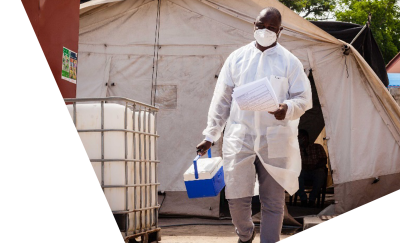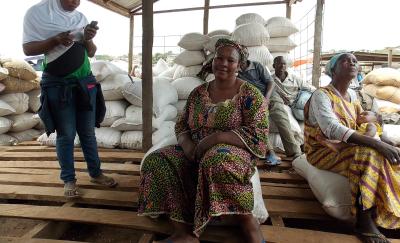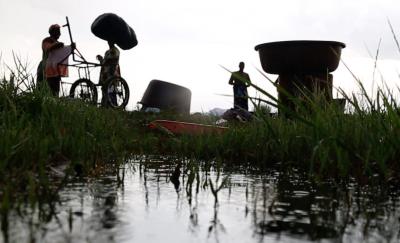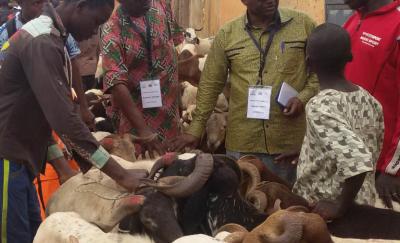We know how to prepare for inevitable epidemics. It takes will and wisdom. Do we have them?
An Abt mini-Master Class with Carolynn Poulsen
.
Throughout the centuries, epidemics, pandemics, and plagues have ravaged the human species, leaving in their wake a staggering loss of life. We have learned a great deal about disease, about prevention—about detection, transmission, and treatment. But one unanswered question looms: do we have the collective will and wisdom to do what’s necessary to address global health security threats?
There’s no question there’s activity: ongoing pandemic agreement negotiations, the World Health Assembly in May, and the United Nations high level meeting for antimicrobial resistance in September. But will there be movement? “This is a key moment to see if we finally break the cycle of panic and neglect,” said Ricardo Echalar, a U.S. Agency for International Development regional emerging threats advisor and a speaker at an Abt Global-sponsored webinar, Navigating Tomorrow's Challenges: Advancing Health Security with Digital Innovation. If we can break the cycle and summon the will and wisdom, there is a clear path to follow.
Farida Sharipova knows that. The medical lab specialist in Khujand, Tajikistan, saw that COVID-19 cases—and deaths—were mounting in 2020. But labs in Tajikistan lacked equipment to use polymerase chain reaction (PCR) technology, the most accurate available to detect, track, and study COVID-19.
Farida—and Tajikistan—were hardly alone. One of the most important lessons to emerge from the COVID-19 pandemic was the vast differences globally in the ability of frontline and national systems to cope with the outbreak.
.
“We saw inequity within countries' populations with more vulnerable people dying at a higher rate,” says Carolynn Poulsen, Abt’s director of global health security. “There were inequities between countries, with some able to buy and distribute COVID-19 vaccines early and cover all of their population, while other countries struggled to gain access.”
Disease “X”
It’s not clear how fast that can change, and how much better prepared the world will be for the next epidemic. What the World Health Organization calls Disease "X" is on the horizon. We don’t know what this threat will be or when it will come. We just know it’s inevitable. History tells us that is so:
The Antonine Plague in 165 A.D., which killed nearly 10 percent of the Roman Empire at the height of its power. The Black Death in the 1300s, the highest estimates for which reflect an estimated 200 million deaths. And more recently severe acute respiratory syndrome (SARS), Middle East respiratory syndrome (MERS), H1N1 swine flu, Ebola, and COVID-19, which has left 7 million dead—and counting.
The risk only grows with human encroachment on animal habitats and environmental factors noted in a recent article in the journal Nature: loss of biodiversity, climate change, chemical pollution, landscape transformation, and species invasion. This requires researchers to expand their repertoire from microscopes to a wide-angle lens to adopt a One Health perspective, which includes human interaction with animals and the environment.
.
“At least 70 percent of emerging infectious diseases that affect humans are zoonotic diseases, which can infect animals and spread to humans and vice versa,” says Poulsen.
Amanda Quintana, Abt’s climate and health technical lead, added in a podcast, that weather and climate experts need to collaborate with health decisionmakers since temperature increases can change where and when disease-carrying mosquitoes thrive and where people live. Weather information systems, she argues, are “early warning systems for health.”
Steve: An Omen for the Future?
Consider Steve. That’s the name the global malaria community has given Anopheles stephensi, a species of mosquito that migrated from Asia to Africa—possibly hitchhiking on a cargo ship—with ruinous effects that reversed significant progress in the fight against malaria in several countries. Over the past three decades, the number of cases globally has declined 50 percent. But in Djibouti, for example, where Steve was detected in 2012, the number of cases rose 30-fold from 2012 to 2019.
.
Climate change played a role in the spike in cases. The effect of changing and extreme weather patterns enables disease carriers such as mosquitoes to thrive in what had been colder, inhospitable regions. But climate change expands disease risks in other ways, too. In Djibouti, it forced many people to move to cities from rural areas, upending successful strategies for combatting malaria. Malaria in Africa had been largely in rural areas, and mosquitoes bit at night in homes. Spraying houses with insecticide and distributing bed nets helped reduce malaria transmission.
But city-dwelling species, like Steve, vastly increase the vector of transmission. Steve usually bites at dusk outside, so bed nets and spraying are less effective. Malaria fighters had to switch to larviciding to kill mosquitoes before they reach adulthood.
This is all-too-typical of the complexity of global health security challenges—and the need for collecting, analyzing, and sharing data from a variety of sources. That necessity led One Health to transform into Digital One Health to improve emergency digital health, data use, and collaboration on a global scale.
The need for international cooperation is not novel. As pandemics recurred over time, it became clear that the way to prevent them was to establish a mechanism for nations to coordinate and agree on standards. The first significant initiative was the international sanitary conferences in 1851. World leaders agreed to adopt standards for the way we manage our individual health systems and the flow of data from information health systems so that each population can protect itself.
Communities: The Critical Front Lines
But such isolation didn’t last long as the speed and spread of travel and trade increased. “Any prior impression that we could protect our health and wellbeing and prevent the spread of infectious disease only within our individual borders has been shattered,” Poulsen says.
Zoonotic diseases such as avian flu are especially hard to detect and control. The pathogens (bacteria, viruses, and parasites) that cause zoonotic diseases have complicated transmission paths, often involving vectors such as mosquitos or ticks. And a variety of species can serve as conduits and hosts: agricultural and veterinary systems, livestock populations, wildlife, and domestic animals. That makes spill over to humans hard to predict and prevent and requires additional layers of surveillance.
Community-based health workers, agricultural extension workers, religious leaders, and civil society organization leaders or community members often are the front lines in the effort. They’re the first people to detect and report a novel disease symptom. During an outbreak, they’re critical to establishing and maintaining communication between the health system and an affected community.
In addition, public and private health providers at the community level often serve as first responders to disease outbreaks, promote initial containment, and seek to maintain the community’s other primary healthcare functions. Local leaders, both formal and informal, are indispensable to effectively translating local norms and practices to external responders when they arrive. Developing community coordination and resilience is therefore one of the fundamental building blocks to developing epidemic preparedness.
.
That’s why it was important for USAID’s Local Health System Sustainability Project to give Farida and about two dozen lab specialists the equipment and training they needed so they could perform hundreds of tests a day to detect and track COVID-19 transmission.
“Our lab’s role during the pandemic has been invaluable,” says Domullojonova Muminakhon, head of the Khujand Sanitary and Epidemiological Service Laboratory. “Doctors have saved the lives of many patients.”
Trust: The Key to Better Health Outcomes
Lab equipment, surveillance tools, data collection and management structures, and health facilities are necessary to prepare for Disease X. But they’re not sufficient. The COVID-19 pandemic proved that. The year before the pandemic, the U.S. and U.K. ranked No.1 and No. 2 respectively in the Global Health Security Index. Yet their COVID-19 responses were atrocious: In March 2023, the U.K. ranked #176 in COVID-19 deaths per 100,000 out of 195 countries, while the U.S. ranked #181.
The “best predictor of pandemic response success was societal interpersonal trust: confidence your neighbor will do the right thing for the common good,” Dr. James White, an Abt senior health specialist, wrote in PLOS Global Health, noting that was the conclusion of studies published in both The Lancet and Scientific Reports.
During and since the pandemic, distrust had grown in government, science, medical institutions, and among neighbors of differing political persuasions. Disinformation and misinformation help evaporate community cohesion and collective action.
Strategic communication to promote behavior change and trust thus is the final tile in the global health security mosaic. Trust can help one country contain an outbreak. But surveillance, Digital One Health, research, data, and all the other bells and whistles are necessary to detect and contain a global outbreak.
“We must think globally and work locally,” says USAID's Echalar. So, the path is clear. But the question remains: do we have the will and wisdom to do what’s necessary?
Abt | Advancing Global Health Security
Disease “X” is on the horizon. We don’t know what this threat will be or when it will come. We just know it’s inevitable. That’s why Abt Global partners with governments and communities around the world to strengthen critical health security capabilities and mitigate the impact of the next great public health crisis.
Abt brings together in-country expertise on human, animal, and environmental health across all functions of the health system and from public and private sectors. Our technical experts deliver multi-sectoral approaches to help countries comply with the International Health Regulations by addressing weaknesses identified through Joint External Evaluation (JEE) and State Parties Self-Assessment (SPAR) tools. Key Global Health Security expertise includes:




